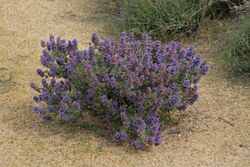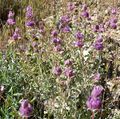Biology:Salvia dorrii
| Salvia dorrii | |
|---|---|

| |
| Scientific classification | |
| Kingdom: | Plantae |
| Clade: | Tracheophytes |
| Clade: | Angiosperms |
| Clade: | Eudicots |
| Clade: | Asterids |
| Order: | Lamiales |
| Family: | Lamiaceae |
| Genus: | Salvia |
| Species: | S. dorrii
|
| Binomial name | |
| Salvia dorrii (Kellogg) Abrams[1]
| |
Salvia dorrii,[2][3] the purple sage,[2] Dorr's sage, fleshy sage, mint sage, or tobacco sage, is a perennial spreading shrub in the family Lamiaceae. It is native to mountain areas in the western United States and northwestern Arizona, found mainly in the Great Basin and southward to the Mojave Desert, growing in dry, well draining soils.[4]
Description
Salvia dorrii is a woody subshrub reaching 10–70 cm (4–28 in) in height and width. The grey-green leaves are narrow and lanceolate, are tapered at the base and rounded at the tip generally without teeth or lobes. They are generally basal, and 1–3 cm (3⁄8–1 1⁄8 in) long. They have an intense but pleasant, mildly intoxicating minty aroma, with the scent released when the foliage is handled or crushed. The inflorescence is made up of spike-like clusters of numerous purple flowers that are bilaterally symmetric. Each cluster is 12–30 mm (1⁄2–1 1⁄8 in) across. Bracts are generally round 5–12 mm (1⁄4–1⁄2 in) long. Each calyx is usually 6–11 mm (1⁄4–3⁄8 in). The upper lip is most often round without teeth or lobes. The lower lip lobes are pointed without spines. The color is variable, blue to purple to rose. The corolla tube is 6–13 mm (1⁄4–1⁄2 in) or so, often blue but sometimes purple to pink to white. The stamens and style protrude from the flower. The latter is forked at the tip. The flowers remain on the plants after being pollinated, with the desiccated flowers remaining for some weeks or months after flowering.[5][6][7][8]
Ecology
It is a larval host plant to the elegant sphinx moth.[9]
Uses and toxicity
Some chemical components found in Salvia dorrii include salvidorol and two epimeric abietane diterpenes.[10]
References
- ↑ {{citation | mode = cs1 | title = Salvia dorrii | work = Germplasm Resources Information Network (GRIN) | url = | publisher = [[Organization:Agricultural Research ServAgricultural Research Service (ARS), United States Department of Agriculture (USDA) | access-date = 2008-03-10 }}
- ↑ Jump up to: 2.0 2.1 "Plants Profile - Salvia dorrii (Kellog) Abrams - (Purple Sage)". USDA. http://plants.usda.gov/java/profile?symbol=SADO4.
- ↑ "Catalogue of Life : 2011 Annual Checklist : Salvia dorrii (Kellogg) Abrams". http://www.catalogueoflife.org/details/species/id/7045012.
- ↑ Sullivan, Steven. K. (2018). "Salvia dorrii". http://www.wildflowersearch.com/search?&PlantName=Salvia+dorrii.
- ↑ "Salvia dorrii". Jepson Herbarium; University of California, Berkeley. 2018. http://ucjeps.berkeley.edu/cgi-bin/get_IJM.pl?tid=Salvia%20dorrii.
- ↑ Giblin, David, ed (2018). "Salvia dorrii". Burke Museum, University of Washington. http://biology.burke.washington.edu/herbarium/imagecollection/taxon.php?Taxon=Salvia%20dorrii.
- ↑ "Salvia Dorrii". Utah State University. http://www.hort.usu.edu/PlantGuide/html/Shrubs_and_Trees/Salvia_dorii.htm.
- ↑ Ward, B. J. (2004). The Plant Hunter's Garden: The New Explorers and Their Discoveries. Timber Press. ISBN 978-0-88192-696-5. https://books.google.com/books?id=FQIIHEHu1EQC&pg=PA101.
- ↑ The Xerces Society (2016), Gardening for Butterflies: How You Can Attract and Protect Beautiful, Beneficial Insects, Timber Press.
- ↑ Ahmed, A. A.; Mohamed, A. el-H. H.; Karchesy, J.; Asakawa, Y. (2006). "Salvidorol, a nor-abietane diterpene with a rare carbon skeleton and two abietane diterpene derivatives from Salvia dorrii". Phytochemistry 67 (5): 424–428. doi:10.1016/j.phytochem.2005.12.009. PMID 16458943.
External links
Wikidata ☰ Q796247 entry
 |





